
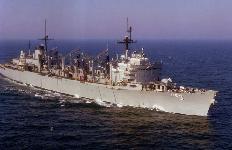

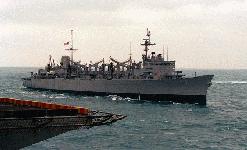
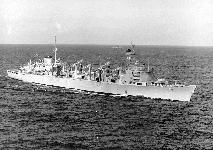
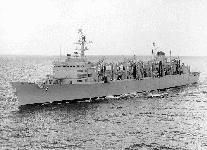
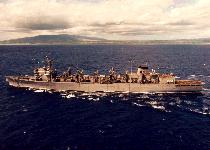

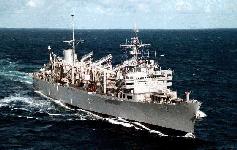
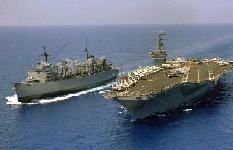
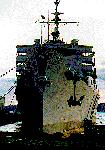
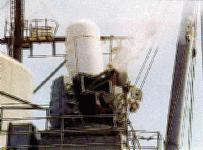
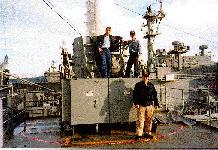
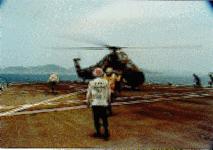
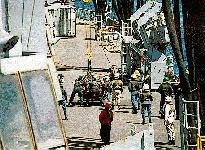
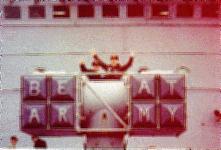
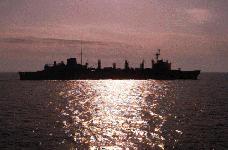
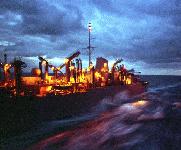





The USS SACRAMENTO class ships combine the functions of three logistic support ships in one hull - fleet oiler (AO), ammunition ship (AE), and refrigerated stores ship (AF). As an oiler (AO) it carries (95% fully loaded) 5.2 million gallons of marine distillate fuel and 2.7 million gallons of aviation jet fuel. About 60-million gallons are pumped each year from this floating filling station to other ships. As an ammunition ship (AE), SACRAMENTO can replenish the entire ordnance requirements of an aircraft carrier in three to four hours. It also carries a complete assortment of missiles and ammunitions for cruisers and destroyers with a capacity of approximately six-thousand tons when fully loaded. In the capacity of a refrigeration ship (AF), SACRAMENTO carries over one-thousand tons of frozen, chilled, and dry food items. Mail is as important as food to sailors. During deployment the SACRAMENTO delivers approximately 100-thousand pounds of mail to forces at sea. Sacramento is capable of carrying over 300 tons of refrigerated provisions, 500 tons of dry provisions and 150 tons of other supplies. While not normally loaded, Sacramento carries 220 different items (dry and refrigerated) and 120 other items when deployed.
These multi-commodity, fast combat support ships have brought an increased capability to the Fleet for the underway replenishment of provisions, combat stores, ordnance and petroleum products. The advanced design of their replenishment facilities and sophisticated cargo-handling equipment effectively accomplishes the rapid transfer of combat consumables at sea by providing "one-stop shopping" for customer ships. In addition, because of their size, these ships also have facilities for limited ship repair and maintenance service, as well as, for other special assignments. This capability for providing on-station combat logistic support contributes to the tactical effectiveness of Carrier Battle Groups or Amphibious Ready Groups operating in any theater of operation. As an example, one AOE can provide integral logistic support for one conventionally-fueled, large-decked aircraft carrier with a full air wing embarked, and three gas turbine powered guided missile escort cruisers or destroyers steaming 12,000 miles, flying 4,000 hours, and reloading a full magazine of ammunition for each. SACRAMENTO is designed to operate with strike forces necessitating fast handling of cargo. A system of elevators and package conveyors permits ready access to ammunition and cargo holds. SACRAMENTO operates a fleet of fork lift trucks, allowing breakout and positioning of cargo and ammunition with greater efficiency. Sophisticated automatic cargo equipment like the Standard Tensioned Replenishment Alongside Method (STREAM), provide rapid transfer of materials from SACRAMENTO to its customers. Fuel is delivered through four double and two single hose (STREAM) fuel lines which are fed by large turbine driven cargo fuel pumps capable of supplying fuel at 40 to 120 psi at a maximum flow rate of three-thousand gallons per minute per pump used. This process is termed FAS for Fueling At Sea. Cargo, ammunition and supplies are moved vertically over seven decks (weather deck, cargo handling and staging deck and five levels of cargo holds) by seven different elevators. Elevators one through six service the four ammunition holds and number seven elevator and a package conveyor service the provisions hold (hold five). The supplies are moved horizontally by a fleet of 33 fork trucks of various types and sizes which allow breakout, positioning and stowage of cargo and ammunition with efficiency. Cargo is delivered by four heavy and three standard lift STREAM cargo stations or by a detachment of two CH-46 helicopters which deploy with the Sacramento. The process of resupplying a ship alongside by means of a fuel or cargo station is termed CONREP for connected replenishment. Vertical replenishment (VERTREP), adds another dimension to SACRAMENTO's ability to transfer freight, mail, personnel, provisions and ammunition. Two Boeing CH-46 jet turbine helicopters (Sacramento has hangar space for three), with replenishment rates of up to 6-thousand pounds per minute, allow delivery to customer ship flight decks. The VERTREP capability allows Sacramento to resupply ships in a dispersed formation, reduces alongside replenishment time, and allows transfer of cargo over greater distances. Additionally, SACRAMENTO can accept other helicopters, for VERTREP support. To support the crew, the ship must be self sufficient in every respect. Personnel onboard have enough expertise in a variety of technical skills to maintain and operate all shipboard equipment. The ship is in essence a floating city and provides services to support and accommodate the crew. The nearly 600 officers and crew are divided into seven departments with each performing a special type of work, coordinated to perform the mission of the ship. Those departments are: Deck, Engineering, Operations, Supply, Medical. Air and Administration. These trained professionals maintain, repair, and operate all shipboard systems. With medical and dental facilities, lounge, gymnasium and library, Sacramento provides for its crew who perform their duties day and night providing fuel, food, supplies, ammunition and mail to the striking forces of the fleet. Sacramento is something of a bench-mark in west coast shipbuilding. It and two of its sister ships, Seattle and Detroit, are the largest ships ever built on the West Coast. Only the lowa class battleships and aircraft carriers have greater displacements than Sacramento. Sacramento's main engines came from the never completed battleship Kentucky and deliver in excess of 100-thousand shaft horsepower to the two 23-foot screws, the largest of any ship in the U.S. Navy. It was originally armed with four, three-inch, 50 caliber guns. The two forward guns which were mounted forward of the bridge on the 01 level were replaced by the NATO Seapsparrow Missile System during the ships second regular overhaul in 1976 and the after gun mounts which were located aft of the stacks on the 04 level were replaced by two Vulcan/Phlanx mounts during the next overhaul in 1981. Sacramento's cargo handling methods and equipment have changed somewhat since 1964 as well. A new metal dunnage system was installed during its 1981 overhaul as were satellite communications and navigation systems and the Super Rapid Blooming Off-Board Chaff (SRBOC) system. Sacramento was originally equipped with the first Fast Automated Shuttle Transfer (FAST) system to handle ammunition and stores. FAST relied on the use of cranes to move missiles and cargo containers on weather decks and hoists to move cargo from the 01 level to the main deck. In 1977 Sacramento's elevators were modified to lift cargo directly to the 01 level and the FAST cranes, transfer rails, and hoists were removed. the new system allowed cargo to be moved from hold to elevator to transfer station using standard electric fork truck and is far less prone to equipment malfunctions. In addition the modern Standard Tensioned Replenishment Alongside Method (STREAM) unrep system was installed.The USS Detriot (AOE-4), a fast combat support ship of the Sacramento (AOE-1) class which is homeported near Philadelphia in Earle NJ, underwent a phased maintenance availability from May through October 1993. The repairs and alterations required 48,000 mandays and over $15 million. The work package included hull, mechanical and electrical work, but was much less intensive in combat systems and electronics than is the work on a combatant ship.
Specifications | |
| Propulsion plant | 2 - turbines, producing 50,000 horsepower at 4,829 rpm |
| Boilers | 4 - boilers - 600 psi at 856oF super-heated steam |
| Main Condenser | cooling water flow rate is 50,000 gallons per minute |
| Main Reduction Gear | Diameter 14 feet, 4 inches |
| FUEL CONSUMPTION | 9,527 Gallons-Per-Hour with all boilers at 100% |
| Propeller | two 23 foot diameter propellers with 6 blades |
| Length: | Overall Length: 795 ft Waterline Length: 770 ft |
| Beam: | Extreme Beam: 107 ft Waterline Beam: 107 ft |
| Draft |
Maximum Navigational Draft: 39 ft Draft Limit: 41 ft |
| Displacement: | 53,000 tons full load Light Displacement: 20144 tons Full Displacement: 51964 tons Dead Weight: 31820 tons |
| Speed: | 26 knots (30 miles, 48 km, per hour) |
| CARGO CAPACITY |
LIQUID CARGO CAPACITY
8,219,387 Gallons ORDNANCE CAPACITY 3,000 Tons PROVISIONS CAPACITY 675 Tons |
| Aircraft: | 2 - CH-46E Sea Knight helicopters |
| BOATS |
2 26' Motor Whale Boats 2 33' Personnel Boats |
| ANCHORS | 2 12-1/2 tons (1,480 of Chain) |
| CRANES | 1 15-Ton (Capacity) |
| Armament: |
NATO Sea Sparrow missiles 2 - Phalanx close-in weapons systems |
| Crew: | 24 officers, 576 enlisted |
| Unit Cost: | $458-568 million |
| Unit Operating Cost Annual Average | ~$37,000,000 [source: [FY1996 VAMOSC] |
Ships | ||||||
| Name | Number | Builder | Homeport | Ordered | Commissioned | Decommissioned |
| Sacramento | AOE-1 | Puget Sound NSY | Bremerton | 08 Aug 1960 | 14 Mar 1964 | |
| Camden | AOE-2 | New York SB | Bremerton | 25 Apr 1963 | 01 Apr 1967 | |
| Seattle | AOE-3 | Puget Sound NSY | Earle | 29 Dec 1964 | 05 Apr 1969 | |
| Detroit | AOE-4 | Puget Sound NSY | Earle | 29 Dec 1965 | 28 Mar 1970 | |
| AOE-5 | 1968 | cancelled 04 Nov 1968 | ||||


















